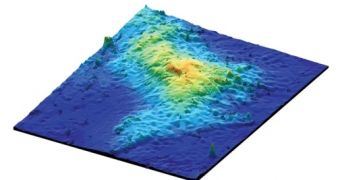The Pacific Ocean is home to the Earth's largest volcano, researchers have recently announced. The volcano sits at a distance of some 1,500 kilometers (932 miles) east of Japan, and is part of an underwater range dubbed the Shatsky Rise.
It measures some 4 kilometers (2.5 miles) in height, and 650 kilometers (404 miles) in width. To put things into perspective, is must be said that this volcano, named the Tamu Massif, stretches over a surface the size of the British Isles or the state of New Mexico.
“This says that here on Earth we have analogous volcanoes to the big ones we find on Mars. I’m not sure anybody would have guessed that,” pointed out William Sager, a marine geologist now working with the University of Houston in Texas.
What the scientist means is that this volcano's width rivals that of Mars' Olympus Mons, a volcano that measures about 625 kilometers (388 miles) across.
Investigations carried out thus far have shown that this ginormous volcano has been lying dormant for roughly 140 million years, Nature reports.
What's interesting is that the scientific community has long been aware of the Tamu Massif's existence. However, researchers worked on the assumption that this mountain came into being in the aftermath of several different volcanic eruptions.
Otherwise put, they assumed that it had been created by a few volcanoes that happened to be located fairly close to each other, and whose lava merged into just one pile.
With the help of air guns, scientists eventually found that the lava flows that formed this mountain had all originated from one central point, i.e. the Tamu Massif's summit.
As William Sager put it, “From whatever angle you look at it, the lava flows appear to come from the center of this thing.”
“We know that it is a single immense volcano constructed from massive lava flows that emanated from the center of the volcano to form a broad, shield-like shape,” the researcher added.
A paper detailing the discovery of this massive underwater volcano and its features will be published in the journal Nature Geoscience this coming September 8.

 14 DAY TRIAL //
14 DAY TRIAL //